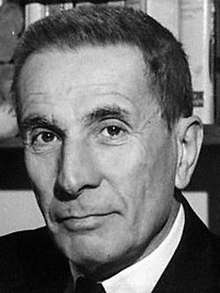Dino Buzzati
Dino Buzzati-Traverso (Italian pronunciation: [ˈdiːno budˈdzaːti]; 14 October 1906 – 28 January 1972) was an Italian novelist, short story writer, painter and poet, as well as a journalist for Corriere della Sera. His worldwide fame is mostly due to his novel The Tartar Steppe, and he is also known for his well-received collections of short stories.
Dino Buzzati | |
|---|---|
 | |
| Born | 14 October 1906 San Pellegrino di Belluno, Italy |
| Died | 28 January 1972 (age 65) Milan, Italy |
| Occupation | Graphic artist, novelist, short story writer, journalist |
| Nationality | Italian |
| Genre | Novel, short story |
| Notable works | The Tartar Steppe |
Life
Buzzati was born at San Pellegrino, Belluno, in his family's ancestral villa. Buzzati's mother, a veterinarian by profession, was Venetian and his father, a professor of international law, was from an old Bellunese family. Buzzati was the second of his parents' four children. One of his brothers was the well-known Italian geneticist Adriano Buzzati-Traverso. In 1924, he enrolled in the law faculty of the University of Milan, where his father once taught. As he was completing his studies in law, he was hired, at the age of 22, by the Milanese newspaper Corriere della Sera, where he would remain until his death. He began in the corrections department, and later worked as a reporter, special correspondent, essayist, editor and art critic. It is often said that his journalistic background informs his writing, lending even the most fantastic tales an aura of realism.
Buzzati himself comments on the connection (as cited by Lawrence Venuti):
It seems to me, fantasy should be as close as possible to journalism. The right word is not "banalizing", although in fact a little of this is involved. Rather, I mean that the effectiveness of a fantastic story will depend on its being told in the most simple and practical terms.[1]
During World War II, Buzzati served in Africa, as a journalist attached to the Regia Marina. After the end of the war, Il deserto dei Tartari was published Italy-wide and quickly brought critical recognition and fame to the author. He married Almerina Antoniazzi in 1966, which also marked release of his last novel, Un amore. In 1972, Buzzati died of cancer after a protracted illness.
Works summary
Buzzati began writing fiction in 1933. His works of fiction include five novels, theatre and radio plays, librettos, numerous books of short stories and poetry. His librettos include four for operas by Luciano Chailly, as well as that of the opera La giacca dannata by Giulio Viozzi.
He wrote a children's book La famosa invasione degli orsi in Sicilia (translated by Frances Lobb into English as The Bears' Famous Invasion of Sicily). Lemony Snicket wrote an introduction and reader's companion to a 2005 English edition.
Also an acclaimed and exhibited artist, Buzzati combined his artistic and writerly exploits into making a comic book based on the myth of Orpheus, Poem Strip.
The Tartar Steppe, his most famous novel, tells the story of a military outpost that awaits a Tartar invasion. In its sentiment and its conclusions, it has been compared to existentialist works, notably Albert Camus's The Myth of Sisyphus.[2]
His writing is sometimes cited as magical realism, social alienation, and the fate of the environment and of fantasy in the face of unbridled technological progress are recurring themes. He has also written a variety of short stories featuring fantastic animals such as the bogeyman and, his own invention, the colomber (il colombre). His Sessanta racconti short-story collection, which won the Strega Prize in 1958, features elements of science fiction, fantasy and horror throughout.[3][4]
His works are highly regarded in France but little known in English.
Bibliography
- Bàrnabo delle montagne (1933)
- Il segreto del Bosco Vecchio (1935)
- Il deserto dei Tartari (The Tartar Steppe, 1940)
- I sette messaggeri (The Seven Messengers, 1942 – short stories)
- La famosa invasione degli orsi in Sicilia (The Bears' Famous Invasion of Sicily, 1945)
- Sessanta racconti (1958 – short stories, received the Strega Prize)
- Il grande ritratto (Larger than Life, 1960)
- Un amore (A Love Affair, 1963)
- Il capitano Pic e altre poesie (1965, poetry)
- Il colombre (1966, Short stories)
- Poema a fumetti (Poem Strip, 1969—comic book)
- Il reggimento parte all'alba (The Regiment Leaves at Dawn, 1985 Short stories)
References
- Restless Nights – Selected Stories of Dino Buzzati (Introduction by L. Venuti) (North Point Press, 1983)
- Sem' Gontsov (Introduction by E. Ambartsumov) (Izvestiya Press, 1985)
- "Sessanta racconti". premiostrega.it (in Italian). Strega Prize. Archived from the original on 2014-06-21. Retrieved 2015-07-13.
- http://www.fantascienza.com/catalogo/autori/NILF10743/dino-buzzati/
- Giuseppe Leone, "Dino Buzzati e le grandi "costruzioni" letterarie – La "fortezza di Bastiani" non è "Il castello" di Kafka", Il Punto Stampa, Lecco, Italy, April 1997.
- Luis Montiel (2010), “Una meditatio mortis contemporánea. La reflexión de Dino Buzzati sobre la caducidad de la vida humana”. Medicina e historia, 2/2010, 1–15.
External links
- Dino Buzzati's official website (in Italian)
- Biography on IMDb
- Biography at the Wayback Machine (archived April 19, 2008) (in Italian)
- Il coraggio della bontà – Dino Buzzati e don Zeno Saltini: cronaca di un'amicizia